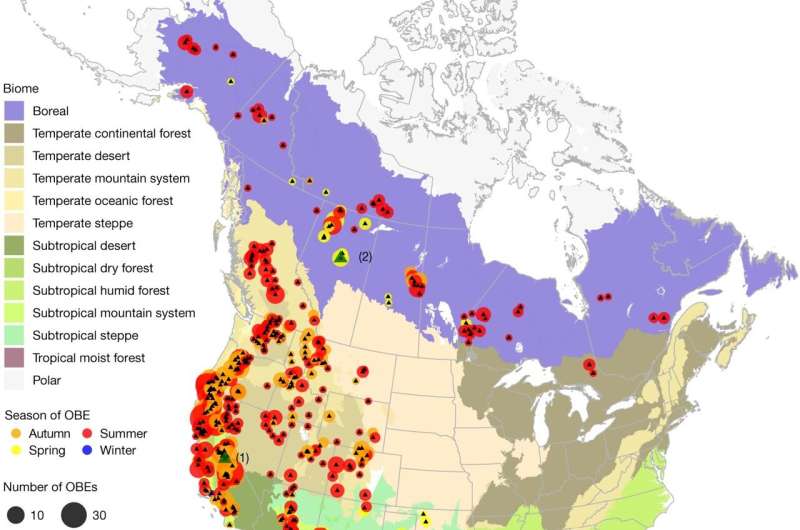This article has been reviewed according to Science X's editorial process and policies. Editors have highlighted the following attributes while ensuring the content's credibility:
fact-checked
trusted source
proofread
'The night might not save us': New study shows drought drives overnight burning of wildfires

The welcomed slowing of a wildfire's destruction that comes with the cool and humidity of nightfall shrinks and even disappears during drought conditions, according to a University of Alberta researcher whose new study published in Nature challenges conventional fire management practices.
"I think it is important to bring this emerging phenomenon to the public to let them know that the night might not save us," says Kaiwei Luo, a Ph.D. student in the Faculty of Agricultural, Life & Environmental Sciences.
Conventional understanding of the "active day, quiet night" fire cycle is that lower temperatures and higher humidity at night naturally slow the progression and intensity of wildfires.
But in recent years, studies and first-hand accounts have shown that an unknown environmental change is enabling wildfires to surpass this natural barrier and burn more powerfully at night.
"Originally, I had thought that since nights are warming faster than days, higher temperatures and the associated lower relative humidity at night would lead to more overnight fires," says wildfire expert Mike Flannigan, U of A professor emeritus and researcher with Thompson Rivers University.
To test this hypothesis, Luo led a team that examined 23,557 fires in North America between 2017 and 2020, using a combination of satellite and terrestrial data to analyze the burn cycle of these fires and identify overnight burning events.
They found that although warming is weakening the climatological barrier to nighttime fires, the main driver of recent overnight burns in large fires was an increase in accumulated fuel dryness, which led to consecutive overnight burns that in some cases lasted weeks.
All told, the authors identified 1,095 "overnight burning events" in 340 individual fires. Nearly all of these events were found in fires larger than 1,000 hectares, with 20% of large fires having at least one overnight burn.
Moreover, when fires burned through the night, it often occurred within two days of ignition, and in 67% of cases they were detected on two consecutive nights, suggesting that one night of burning often leads to a second.
"In the extreme cases, there would be no difference between an overnight burn event and daytime burning," says Luo.
And while this overnight burning limits containment opportunities and stretches already thin resources even further, Luo says understanding this new wildfire reality could facilitate early detection and improved fire management.
"The presence of daytime drought conditions could act as a predictor of overnight burning events the following night," he says.
"Nighttime burning has long been overlooked. In a warmer and drier world, we can use daytime drought indicators to predict the night."
Flannigan adds more overnight burn events also means more firefighting resources will be needed, and if fire management agencies want to fight fires at night, they need additional training and equipment.
"More of these fires also increases the likelihood of a catastrophic fire."
More information: Kaiwei Luo et al, Drought triggers and sustains overnight fires in North America, Nature (2024). DOI: 10.1038/s41586-024-07028-5
Provided by University of Alberta





















